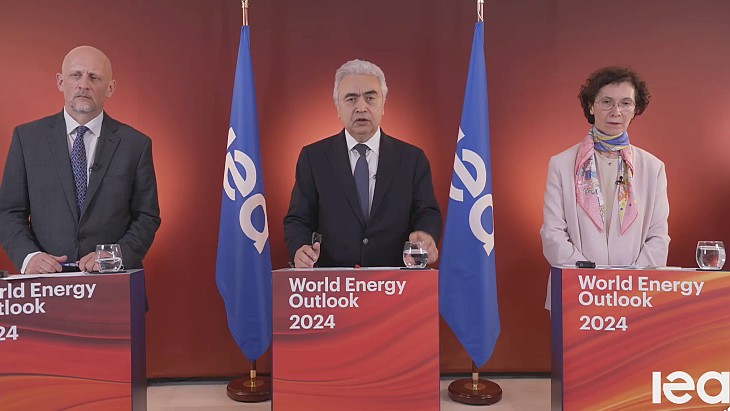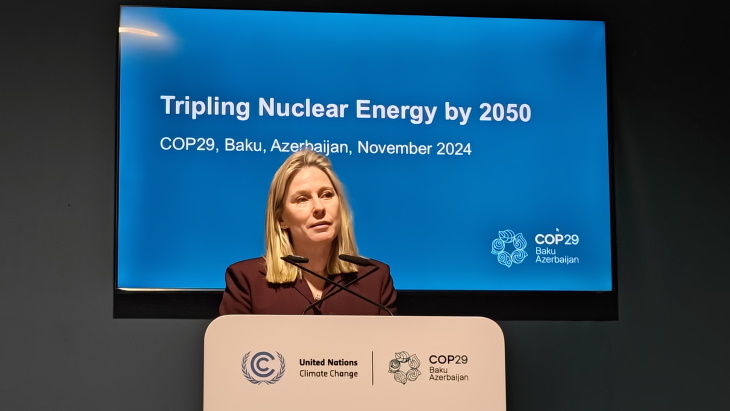Report highlights nuclear's contribution to SDGs
.jpg)
In 2015, all UN Member States adopted the 2030 Agenda for Sustainable Development and its 17 Sustainable Development Goals. These provide a universal set of goals, targets and indicators against which nations will be expected to frame policies over the next 15 years. The goals recognise that ending poverty and other deprivations must go hand-in-hand with improving health and education, reducing inequality, and spurring economic growth - all while tackling climate change and protecting the environment.
The new report - titled Nuclear's contribution to achieving the UN Sustainable Development Goals - was produced through collaboration by the Canadian Nuclear Association (CNA), European nuclear trade body Foratom, the Japan Atomic Industrial Forum (JAIF), the Nuclear Energy Institute (NEI), the Nuclear Industry Association (NIA) and World Nuclear Association.
It highlights how nuclear technologies contribute to addressing issues such as eliminating hunger, improving health, providing access to affordable and clean energy, generating decent work and economic growth, and mobilising climate action.
| Goal | Nuclear's contribution |
|---|---|
| 1. No poverty | • Nuclear generation provides affordable and reliable electricity supplies without greenhouse gas emissions or air pollution. • Investment in nuclear energy boosts economies and provides employment. |
| 2. Zero hunger | • Nuclear technologies help fight against pests, avoiding the need to resort to harmful pesticides. • Using nuclear techniques to develop new plant breeds means that farmers can grow crops that need less water and that are more resistant to the impacts of climate change. • Fresh food can last longer if irradiated, and this process also kills E. coli, listeria and salmonella. |
| 3. Good health and well-being | • Every year, nuclear medicine helps doctors diagnose and treat tens of millions of people. • Nuclear materials are essential for medical research, as they are used to analyse specific molecules inside the body. • Radiotherapy helps treat and cure many kinds of cancer. • Irradiation is used to sterilise medical equipment, such as syringes and catheters. |
| 4. Quality education | • The nuclear industry offers long-term, high-skill jobs. • Companies invest in training and education to encourage the development of a workforce with the skills required to construct and operate their plant. |
| 5. Gender equality | • Lack of access to clean, reliable and affordable energy disproportionately disadvantages women and girls. • Nuclear companies have signed up to initiatives encouraging young women to move into STEM careers, and to provide training to prevent discrimination and fight against bias. |
| 6. Clean water and sanitation | • Nuclear energy has a central role to play in achieving universal access to clean water and sanitation. • Desalination of seawater using heat generated by nuclear reactors produces pure, clean water, without the greenhouse gases emitted by the fossil fuel plants that power desalination units. |
| 7. Affordable and clean energy | • Demand for electricity is increasing, driven by a growing global population, increasing electrification of energy supply, and the needs of the billions of people who still don’t have access to affordable and reliable electricity supplies. • Meeting this increasing demand for electricity by burning fossil fuels is not sustainable. Switching to clean technologies such as nuclear energy is vital. • If the world is to help lift people out of poverty and meet energy demand, then significant investment in low-cost, low-carbon nuclear energy is needed. |
| 8. Decent work and economic growth | • Construction of a new nuclear power plant generates thousands of jobs onsite and thousands more in the supply chain. • The operation of a nuclear power plant provides hundreds of high-skill jobs for people in local communities for many decades. • A nuclear power plant brings broader investment that benefits local economies. |
| 9. Industry, innovation and infrastructure | • Innovative designs allow nuclear reactors to operate in new locations and enable decarbonisation in new applications beyond electricity supply. • High-temperature reactors will offer an alternative to fossil fuels for process heat and provide new options for hydrogen production. • Innovations in nuclear fuel can enhance the performance of reactors in operation today. |
| 10. Reduced inequalities | • The overall generation costs of nuclear plants are less susceptible to price volatility than fossil plants. Rising fuel costs can have an inequitably high impact on lower-income households. • Using nuclear power enables those countries with limited domestic fossil fuel reserves to have greater control over their own energy systems. |
| 11. Sustainable cities and communities | • Over half the population in the world’s cities endures worsening air pollution. One major contributor to air pollution in cities is the exhaust fumes from petrol or diesel road vehicles. • Using nuclear generation to recharge electric vehicles helps reduce transport greenhouse gas emissions as well as reducing air pollution in cities. • Nuclear power plants can also be used for district heating, avoiding pollution from fossil fuels. |
| 12. Responsible consumption and production | • Responsible consumption and production should still allow everyone to enjoy a high quality of life, with sufficient energy supplies to enable the achievement of all of the Sustainable Development Goals. • Nuclear power plants supply large amounts of electricity from compact sites, using fuel that has the potential to be recycled. |
| 13. Climate action | • The effects of climate change caused by anthropogenic (human-caused) emissions are numerous and far-reaching. • Nuclear plants avoid the emission of over 2 billion tonnes of carbon dioxide each year. • New nuclear power plants can be deployed at scale, enabling rapid decarbonisation of a country’s electricity generation mix. |
| 14. Life below water | • By generating electricity without producing carbon dioxide, nuclear reactors help reduce ocean acidification caused by burning fossil fuels. • Nuclear techniques can help monitor the health of aquatic ecosystems. |
| 15. Life on land | • Nuclear energy plays an important role in preserving biodiversity, thanks to its uniquely small physical footprint. • Mining for coal to power fossil fuel generation plants can result in destruction of forests. |
| 16. Peace, justice and strong institutions | • Signatories to the Non-Proliferation Treaty undertake to not pursue a nuclear weapons programme and cooperate on peaceful uses of nuclear technology. • Nuclear techniques can also be used to detect weapons and drugs. |
| 17. Partnerships for the goals | • To implement the other 16 Sustainable Development Goals, governments, civil society, scientists, academia, and the private sector need to work together, combining their skills and expertise to be better able to achieve a common objective. • Organisations such as CNA, Foratom, JAIF, KAIF, NEI, NIA and World Nuclear Association bring representatives of different nuclear companies together to work on areas of common interest and engage with other stakeholders. |
"Nuclear energy provides the clean, on-demand affordable electricity needed to meet the world's growing energy demands, while fulfilling the climate objectives of the Paris Agreement," said World Nuclear Association Director General Sama Bilbao y León. "But nuclear technologies do so much more! The planet and humanity are much better off because of the many nuclear contributions to achieving each of the 17 UN Sustainable Development Goals."

_99697.jpg)







..._58412.jpg)

